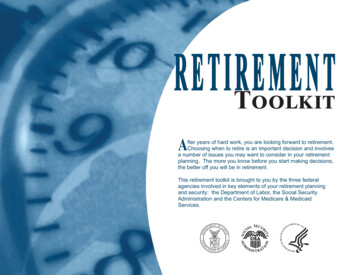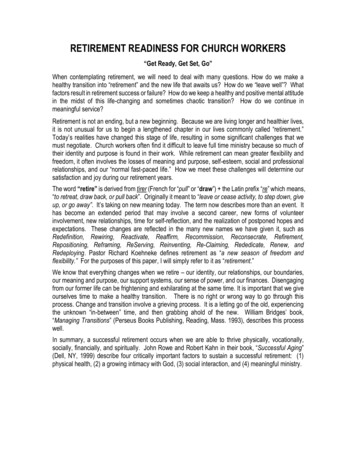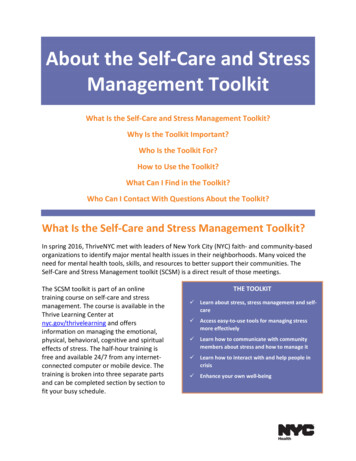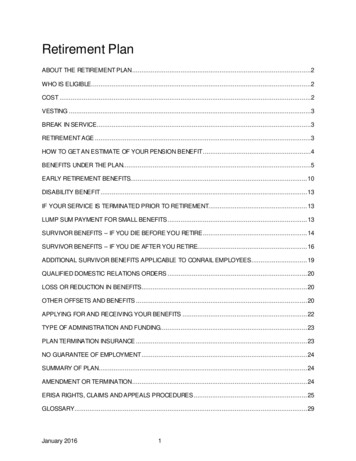
Transcription
RETIREMENTToolkitAfter years of hard work, you are looking forward to retirement.Choosing when to retire is an important decision and involvesa number of issues you may want to consider in your retirementplanning. The more you know before you start making decisions,the better off you will be in retirement.This retirement toolkit is brought to you by the three federalagencies involved in key elements of your retirement planningand security: the Department of Labor, the Social SecurityAdministration and the Centers for Medicare & MedicaidServices.
The toolkit includes a list of publications and interactive tools to help in your planning, plus information on how to contactus with your specific questions. It is important to start early and be well informed so you can make timely decisions and, ifnecessary, make changes while you still have time before retirement. The timeline below can help you plan for the kind ofretirement you want.Timeline for Retirement Planning 5059½626566Begin makingcatch-upcontributions,an extraamount thatthose overage 50 canadd to 401(k)and otherretirementaccounts.Check yourSocial SecurityStatementonline everyyear forearningsaccuracy andto learn whatyour estimatedbenefits willbe.No more taxpenalties onearly withdrawalsfrom employerprovidedretirementsavings planssuch as 401(k)plans andother individualretirementaccounts, butleaving money inmeans more timefor it to grow.Also, withdrawalswill be taxed asregular income.Earliest ageto collectSocial Securityretirementbenefits;however,claimingbefore thefull retirementage results inreduced monthlybenefits.Sign up forMedicare andMedicare Part D.6770 ------------------------------------ ReceiveSocialSecurity fullbenefits,dependingon yourbirth year. --------------------------------------------- Earn Social SecurityDelayed RetirementCredits, whichincrease monthlybenefits for eachmonth claiming isdelayed between thefull retirement ageand age 70.72Start takingminimumwithdrawals frommost retirementaccounts by thisage; otherwise,you may becharged heavypenalties in thefuture.
Retirement Saving PlansYour employer’s retirement savings plan is an essentialpart of your future financial security. If you have a 401(k) orother retirement savings plan at work, sign up and contributeall you can. If your employer also contributes to the plan,sometimes as a matching contribution, find out how muchthe employer match is and how much you need to contributeto get all of it. As noted in the timeline, at age 50, you canbegin making catch-up contributions to save even morefor retirement. Don’t touch your retirement savings. Thelonger you leave the money there, the more time it has togrow. If you take money out too early, before age 59½, notonly do you lose principal and interest but you may have topay a tax penalty. At age 72, you will need to start taking acertain amount out, called a required minimum distribution,or risk paying a penalty. If you reached 70½ before 2020,you may have a required minimum distribution for 2021even though you’re not yet 72.It is also important to understand how your plan worksand what benefits you will receive. Learn about thedifferent features or provisions of your plan. Ask yourplan administrator, human resource office, or employer forinformation. Also learn about the rights and responsibilitiesyou have under the federal law that governs your plan, theEmployee Retirement Income Security Act (ERISA).While you are working, take a look at how much you havesaved for retirement, how much you might receive in SocialSecurity benefits, and what other assets you have. Also,look at your current expenses and think about what they willbe in retirement. For instance, your work-related costs willlikely go down, while health care costs likely will increase.Starting now can help you make changes while there is timebefore you retire to make up any savings gap or adjust yourgoals. Also remember to check your plan at least once ayear to see if you need to make changes to stay on trackto a secure retirement. Routinely monitoring your onlineaccount and information is also one of the basic steps youcan take to reduce the cybersecurity risk of fraud or loss toyour retirement account.If your plan is a 401(k) or similar type plan, your individualbenefit statement should include two illustrations of youraccount balance as a stream of estimated monthly lifetimepayments. You can use the illustrations of your accountbalance as monthly payments in retirement to help youprepare for retirement.Social SecurityChoosing when to begin receiving Social Security benefitsis an important part of deciding when to retire. If you chooseto start receiving benefits when you reach full retirementage, you will receive your full benefit. If you delay claimingbenefits beyond full retirement age, you can earn creditsthat increase your monthly benefit by about eight percentfor each year you delay claiming, up to age 70. If you startcollecting Social Security benefits before you reach fullretirement age, your benefits will be reduced by up to 30percent, depending on when your benefits start.
Social Security’s full retirement age depends on the yearin which you were born. If you were born between 1943 and1954, your full retirement age is 66. If you were born between1955 and 1959, your full retirement age increases graduallyuntil it reaches age 67 for those born in 1960 or later.If you claim benefits before your full retirement ageand continue to work, your income will be subject to theretirement earnings test and your benefits could be reducedif your earnings exceed a certain limit. However, onceyou reach full retirement age, your monthly benefit will beincreased permanently to account for any months in whichbenefits were reduced. The retirement earnings test nolonger applies after you attain your full retirement age andyour benefit will not be reduced no matter how much youearn. Once you claim benefits, your benefits will be adjustedannually to reflect the increase, if any, in the cost-of-living.MedicareParts A & BIf you’re already getting Social Security benefits, you’llautomatically get Medicare Part A (Hospital Insurance) andMedicare Part B (Medical Insurance) starting the first dayof the month you turn 65. If your 65th birthday is on the firstday of the month, Part A and Part B will start the first day ofthe prior month. Medicare will mail you a Medicare card andgeneral information before the date you become eligible.People under 65 with certain disabilities who’ve beenentitled to Social Security disability benefits for 24 monthsare enrolled in Medicare automatically. People of any agewho have End-Stage Renal Disease (ESRD), also qualify forMedicare, but must file an application to enroll.In most cases, you usually don’t pay a monthly premiumfor Part A coverage if you or your spouse paid Medicaretaxes while working. However, Medicare Part B is a voluntaryprogram that will normally require you to pay a monthlypremium. If you don’t want to keep Part B, you must followthe directions when you get your Medicare card to letMedicare know you don’t want it. Otherwise, keep your cardand you’ll be charged the Part B premium.If you aren’t receiving Social Security benefits by age 65and you want to enroll in Medicare, you should contact SocialSecurity and sign up during your Initial Enrollment Period. Inmost cases, this is the seven-month period that starts threemonths before the month you turn 65, includes the month youturn 65, and ends three months after the month you turn 65.Important: In most cases, if you don’t sign up for MedicarePart B when you’re first eligible, you may have to pay alate enrollment penalty for as long as you have Medicarecoverage.If you’re covered under a group health plan based on youror your spouse’s current employment, you should contactyour employer benefits administrator to see if it might bebest to postpone Part B enrollment until you or your spouseretires. This decision will depend on how your insuranceworks with Medicare. Once your employment ends, you’llhave an eight-month Special Enrollment Period in which to
sign up for Part B. You won’t have to pay a penalty if you signup during this period.Note: These eligibility rules are general and apply topeople who are nearing their 65th birthday. Visit Medicare’swebsite to learn about eligibility rules for other situations.Parts C & DYou must have Medicare Parts A and B to join a MedicareAdvantage Plan (Part C). You must have Part A or B to getMedicare prescription drug coverage (Part D).There are specific times when you can sign up forMedicare Advantage (Part C) and Medicare prescription drugcoverage (Part D), or make changes to coverage youalready have:1. When you first become eligible for Medicare2. Between October 15–December 7 each year.3. Medicare Advantage Open Enrollment Period—January 1-March 31 each year. If you enrolledin a Medicare Advantage Plan during your InitialEnrollment Period, you can change to anotherMedicare Advantage Plan (with or without drugcoverage) or go back to Original Medicare (with orwithout a drug plan) within the first 3 months youhave Medicare.4. Under certain circumstances that qualify you for aSpecial Enrollment Period.Important: To avoid paying a Part D late enrollmentpenalty, you’ll need to sign up for Part D when you firstbecome eligible for Medicare or you’ll need to show proof ofcreditable drug coverage if you join the plan later. Creditableprescription drug coverage is coverage that’s expected topay, on average, at least as much as Medicare’s standardprescription drug coverage. Your current employer healthplan tells you each year if your drug coverage is creditablecoverage.Elder Rights and Protection against Fraud andAbuseElder abuse, including financial exploitation and fraud, isa growing problem. Financial exploitation can take manyforms, including cashing checks without permission; misusingor stealing money or possessions; coercing or deceiving anolder person into signing a legal document; and the improperuse of conservatorship, guardianship, or power of attorney.Concerned individuals who spot the warning signs of apossible problem can call state and local agencies for help.Additional Information on:Retirement savings plans, pensions, and healthplansTaking the Mystery Out Of Retirement Planning –This publication assists individuals who are within 15years of retirement to calculate their income, savings,and likely expenses in retirement in order to understandhow much more they need to save.Also available in Spanish.
Savings Fitness: A Guide to Your Money and YourFinancial Future – This financial planning tool providesan easy-to-follow process for setting goals and priorities,as well as how to include a secure retirement as part ofan overall financial plan.Also available in Spanish.Top 10 Ways to Prepare for Retirement – Thispublication provides 10 steps to help you get startedpreparing for retirement.Also available in Spanish.Women and Retirement Savings – This publicationgives helpful tips for women.Also available in Spanish.Filing a Claim for Your Retirement Benefits – Thispublication describes the plan’s obligations and brieflyexplains the procedures and timelines for filing a claimfor retirement benefits.Also available in Spanish.What You Should Know About Your Retirement Plan– This booklet helps you understand your retirementplan and explains what information you should reviewperiodically and where to go for help with questions.Also available in Spanish.Can the Retiree Health Benefits Provided by YourEmployer Be Cut? – This publication explains howsome employer-provided health care plans can carryover to retirement. It is important to understand howsecure those benefits are.A Look at 401(k) Plan Fees – More and moreemployees are investing in their futures through 401(k)plans. The publication highlights the most commonfees to help 401(k) plan participants to make informedinvestment decisions.Life Changes Require Health Choices.Know YourBenefit Options – This booklet addresses marriage,divorce, loss of a spouse, and other life events that mayrequire changes in your health coverage.Also available in Spanish.Work Changes Require Health Choices – ProtectYour Rights – This booklet addresses retirement, jobloss, and other work events that may require changes inyour health coverage.Also available in Spanish.QDROs – Qualified Domestic Relations Orders –This publication provides information about the divisionof a participant’s interest in a retirement plan duringseparation, divorce, and other domestic relationsproceedings.
Online Security Tips – Basic steps you can taketo reduce cybersecurity risks of fraud or loss to yourretirement account.Social Security BenefitsRetirement Benefits – This publication provides anoverview of Social Security and Medicare benefits.Also available in Spanish.What Every Woman Should Know – Social Securityplays an important role in providing economic securityfor women. This publication provides information abouteligibility for Social Security retirement, disability,divorced spouse, and widow’s benefits.Also available in Spanish.When To Start Receiving Retirement Benefits – Thispublication explains your options in deciding when toretire and how that decision affects the benefits you willreceive for the rest of your life.Also available in Spanish.How Work Affects Your Benefits – This publicationexplains the earnings limit for people who are underthe full retirement age when they apply for retirementbenefits and continue to work and get benefits.Also available in Spanish.Windfall Elimination Provision – This publicationexplains how your retirement benefit may be reduced ifyou worked for an employer, such as a governmentagency, who did not withhold Social Security taxes fromyour salary.Government Pension Offset – This publication explainsthat if you receive a pension from a federal, state, or localgovernment based on work where you did not pay SocialSecurity taxes, your Social Security spouse’s or widow’s orwidower’s benefits may be reduced.mySocial Security – Your personal online “mySocialSecurity” account is a valuable source of information ateach stage of your life, from your working years throughretirement. While working, you can use it to access yourSocial Security Statement.Estimate your retirement benefits – The RetirementEstimator is tied to your Social Security earnings recordand provides highly accurate benefit estimates for thosenearing retirement age. The Estimator is interactive,allowing the user to compare different retirement options.Also available in Spanish.
Retirement Benefits Website – This retirementwebsite provides detailed information about your SocialSecurity benefits under current law. It also points outthings you may want to consider as you prepare for thefuture.Also available in Spanish.Apply Online for Retirement Benefits – When you areready to apply for retirement benefits, apply online fromthe comfort of your home or office. It’s easy and secure.Just fill in the answers to the application questions andselect the “Submit Now” button at the end to send usthe application.Multilanguage GatewayMany of our publications also are available in more thana dozen other languages. Please visit our MultilanguageGateway to learn more.Medicare BenefitsMedicare (SSA Publication No. 05-10043) – Thisbooklet provides basic information about what Medicareis, who is covered, and some of the options you have forchoosing Medicare coverage.Also available in Spanish.Medicare & You (Publication No. CMS-10050) – Thisgeneral guide provides more information on the benefitsavailable under Medicare and the eligibility periods. Itis mailed to individuals after they enroll in Medicare. Anupdated version is mailed each fall.Also available in Spanish.Enrolling in Medicare Part A & Part B(Publication No. CMS-11036) – Learn more about enrollment in Medicare Part A and B, including who cansign up, when you can sign up, and how the timing canaffect your costs.Also available in Spanish.Get Help with Your Medicare Costs – To get help withMedicare costs, you must be on Medicare, have limitedincome and resources, and reside in one of the 50 statesor the District of Columbia.Also available in Spanish.Extra Help with Medicare Prescription Drug PlanCosts – To get help with Medicare prescription drug plancosts, you must be on Medicare, have limited incomeand resources, and reside in one of the 50 states or theDistrict of Columbia.Also available in Spanish.
Applying for Medicare Only – This document providesinformation on signing up for Medicare Parts A and B atage 65 for those individuals not yet ready to claim SocialSecurity benefits.Also available in Spanish.Help in Other LanguagesMany Medicare publications are available in other languages. Please visit Medicare’s website to learn more.Elder Rights and Protection Against Fraud andAbuseNational Center on Elder Abuse (NCEA) -- NCEA hasresources and information on financial exploitation andfraud. Individuals who suspect elder abuse or neglect canfind state resources, helplines, and hotlines, or can callthe Eldercare Locator at 1-800-677-1116 for state-specificinformation.National Elder Fraud Hotline – The U.S. Departmentof Justice provides a free hotline to report fraud againstanyone 60 or older. Their experts will help you navigatethe process at the local, state, and federal levels. Call833-FRAUD-11 or 833-372-8311.Contact UsU.S. Department of Health and Human ServicesCenters for Medicare & Medicaid Services1-800-MEDICARE (1-800-633-4227)TTY: 1-877-486-2048U.S. Department of LaborEmployee Benefits Security AdministrationAsk EBSA1-866-444-3272TTY: 202-501-3911U.S. Social Security Administration1-800-772-1213TTY: 1-800-325-0778
Retirement Saving Plans Your employer’s retirement savings plan is an essential . If you claim benefits before your full retirement age and continue to work, your income will be subject to the . this is the seven-month period that s










